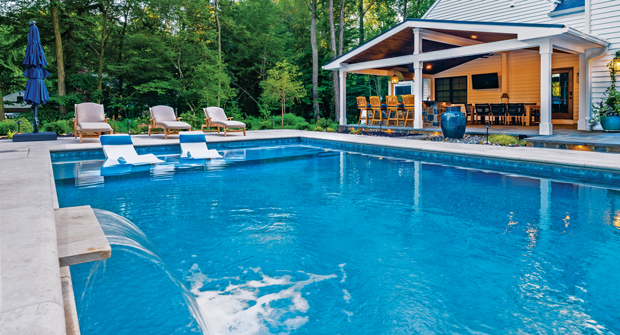
From growing environmental concerns to changes in the materials requested, trends for design/build projects continue to evolve across the country.
Connecting spaces
After the pandemic, homeowners began asking for more luxurious outdoor spaces in their backyards, says David Mull, landscape architect for DiSabatino Landscaping in Wilmington, Del. The company offers design/build, landscaping, landscape maintenance, landscape lighting, exterior additions and interior construction services to residential properties.
Staycation projects include features like patios with grill stations, pavilions, resort-quality pools and other design/build trends from areas like Arizona, California and Florida, Mull says. Customers seek ways to extend their living areas and want outdoor designs to mirror the rest of their homes.
“People want a stronger connectivity between their indoor and outdoor spaces,” Mull says. “The details and finishes you put in the outdoor space are very important, so you want them to relate architecturally to the rest of the house.”
Homeowners are moving away from concrete pavers and brick retaining walls and requesting natural materials like flagstone, porcelain, exposed aggregate concrete and boulders, he says.
“Travertine marble pavers are also popular because the appearance is cleaner and more contemporary, and they’re cooler under your feet when you walk on them,” Mull says.
Shift in materials
Customers are looking to incorporate products that are sustainable and cutting-edge, says Joel Tomlin III, landscape designer at Milosi Landscape in Hendersonville, Tenn. About 75 percent of the company’s work is residential design/build, with the rest being landscape and snow maintenance for residential and commercial properties.
“Now, they want to be more environmentally conscious and are more interested in the details of their project,” Tomlin says.
In the past, Tomlin’s team installed real quarried stone and brick patios and walls, but that trend has decreased and shifted to materials like porcelain pavers and concrete. Low-maintenance plant material has also become more popular in designs, along with artificial turf.
For pools, they’re installing more glass tiles and LED lighting. “The whole LED factor gives us more underwater options,” Tomlin says. “The lighting has really been fantastic.”
Natural approach
Customers are realizing the benefits of being outside and connecting with nature, so they are willing to spend more on outdoor living spaces, says Andy Blanchford, CEO of Blanchford Landscape Group in Bozeman, Mont. His company offers landscape design/build, garden and holiday décor services to residential customers.
To extend the use of the outdoor spaces, homeowners look to add structures for shade and lights, fire features and comfortable seating areas. “They want to make it a space that can be used for three seasons of the year,” Blanchford says.
They’re also focusing more on native plants, site-appropriate landscaping and other environmentally friendly components — like small, subtle lighting that doesn’t pollute the sky with light. Adding water features is another way to tie the projects back into nature.
“It’s nice to incorporate some kind of water into landscapes for the soothing sound and the ability to muffle out some of the surrounding noises,” Blanchford says. “It doesn’t have to be huge or fancy — just a boulder bubbling fountain in an intimate space.”
As for trends that have faded away, Blanchford says his crews aren’t installing many large, woody shrubs anymore. Instead, they focus on trees and perennials, which can freshen up the landscape. They’ve also cut back on the amount of sod they install — going from 100,000 square feet of sod a year in the past to less than 20,000 square feet now.
“Most of our projects don’t have lawns,” Blanchford says.
Looking ahead, Blanchford and his team are open to trends and anything that helps their customers better connect with nature. “We’re just continuing to find things that invite people outdoors,” he says.

